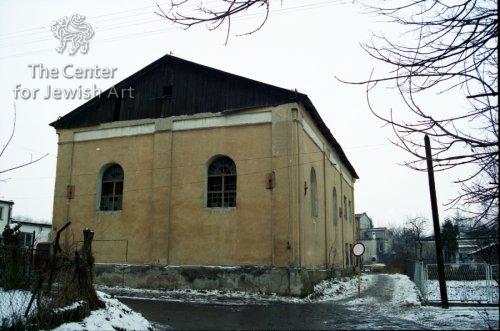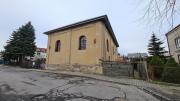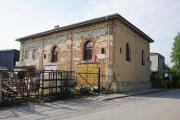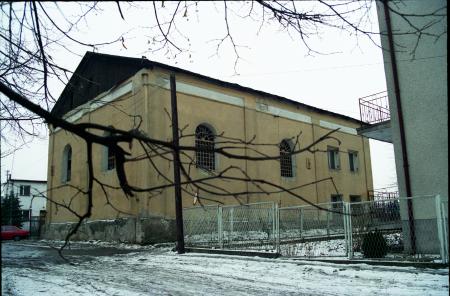Obj. ID: 1071
Jewish Architecture Synagogue in Bychawa, Poland

The synagogue in Bychawa was built in 1811, according to an inscription: “The building that is built by Yitzhak of son of the late Mordecai in 1811, from the windows to the walls and ceiling, including Torah Ark”.
The synagogue in Bychawa is a rectangular building with six windows on the west side looking into the prayer hall and women's gallery. The plan of the building based on a vaulted ceiling and four large central pillars of the bimah that divides the space into nine bays. In the interior (on the bimah and eastern wall) fragments of inscriptions and murals are preserved. Among the murals are images of four animals and musical instruments. Above the bimah there is a depiction of the 'four animal' motif. These murals were probably made during the early 20th century. The inscriptions belong to the time of the synagogue's construction.
For the interior see:
See also:
Text from Virtual Shtetl Website:
The first reference to a wooden synagogue in Bychawa dates back to 1717. The records dated from 1787 onward also mention a house of prayer located directly next to the synagogue. Wooden objects were most probably consumed by fire at the beginning of the 19th century as in about 1810 they were replaced by new brick buildings of the synagogal compound. The synagogue is built on a rectangular ground plan and it houses a prayer hall with a so-called bimah-support. It has modest elevations divided by pilasters. The synagogue is located on Kościuszki Street (formerly called Bożnicza.) In 1876 it was destroyed by the fire that broke out in the town in 1876, when also a house of prayer next to the synaogue burned down. The Jews did not wait for the synagogue to be rebuild and opened a house of prayer in a private apartment of Chaim Rubinowicz. However, the Jewish community reconstructed the synagogue in 1899.
The bigger part of the synagogal compound was destroyed by the Nazis during the occupation. After the war, the synagogue was partly rearranged and handed over to the fire brigade. A devastated house of prayer was pulled down in 1945 while the building of a mikveh housed a rubber manufacturing plant.
Postwar reconstruction works deprived the synagogue of its former look and layout – a gable roof was built and new partitions as well as the women’s section and the vestibule were rearranged. A brick bimah was preserved. Traces of Hebrew inscriptions and paintings with motifs of animals and musical instruments survived, though suffering from the way the building was used. The niche left after the Torah ark and the women’s section on the first floor with nine openings connecting it to the hall room were preserved.
The synagogue compound in Bychawa was severely damaged during the Nazi occupation. A house of prayer near the synagogue was pulled down after 1945. After the war the synagogue was partly rebuilt (the roof was replaced and the partitions of the vestibule and a women’s section were modified) and handed over to the fire brigade. The buidling housed a storehouse of the Municipal Services Office.
On both sides of the Torah ark two foundation plaques have been preserved. These include the date 1810-1811.
The first plaque reads: This is a house which was built by Itzchak for the Lord, to be His fortress, for His soul and His heart. And all the works were completed, with the windows, the roof on the top, walls, Holy Ark of the Lord God; the whole limit thereof round about shall be most Holy (Ez. 43:12.) He who build the house of the Lord – generous, wealthy and our prominent teacher Itzhak, son of our late teacher, Mordechai, blessed be his name. This place nearby for our learned teacher (illegible text). In the year 571.
On July 23rd 2007, the Jewish Religious Community in Warsaw regained the synagogue under the Jewish Property Restitution Act of 1997. The community entrusted the synagogue to the care of the Foundation for the Preservation of Jewish Heritage. In November 2007 the Foundation sold the edifice to a private entity. Right now the building is not used and closed to the public.
sub-set tree:
Andrzej Trzciński, The Traces of Monuments of Jewish Culture in the Lublin Region ([Lublin], [1989]), p. 27.
Bergman, Eleonora and Jan Jagelski. Zachowane synagogi i domy modlitwy w Polsce. Katalog (Warsaw: Jewish Historical Institute, 1996)
Burchard, Przemysław. Pamiątki i zabytki kultury Żydowskiej w Polsce (Warsaw: Burchard Edition, 1990), p. 161.









